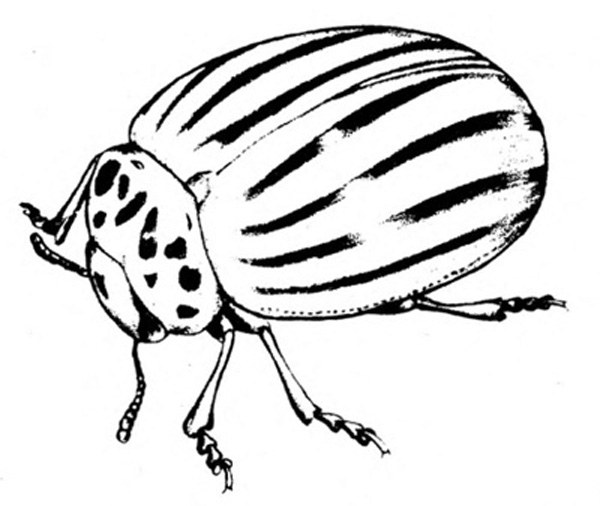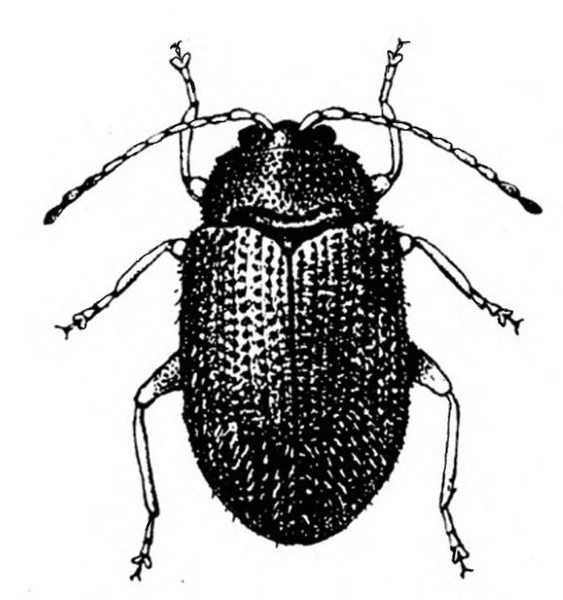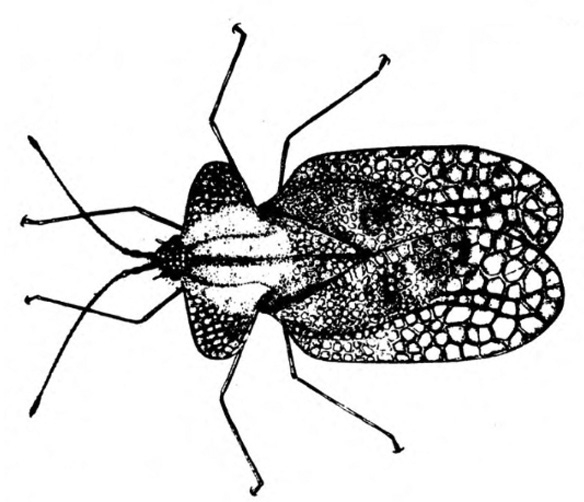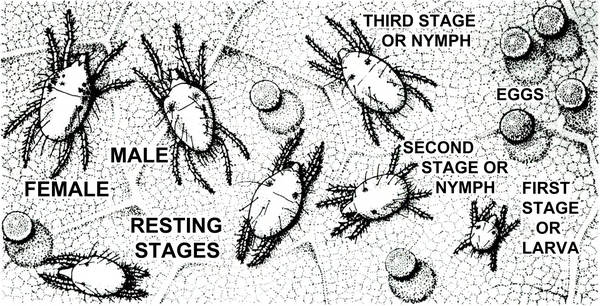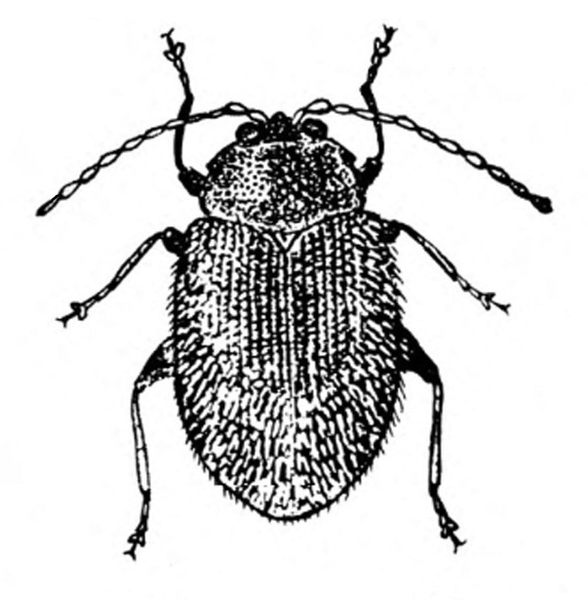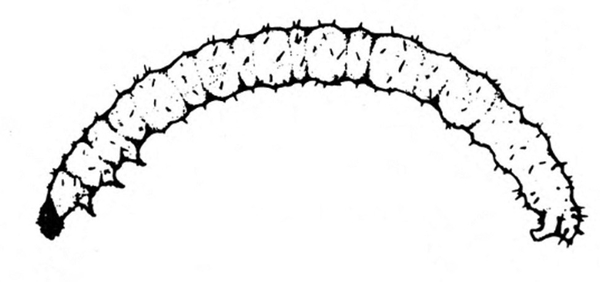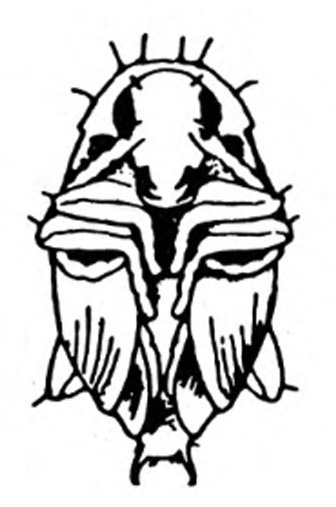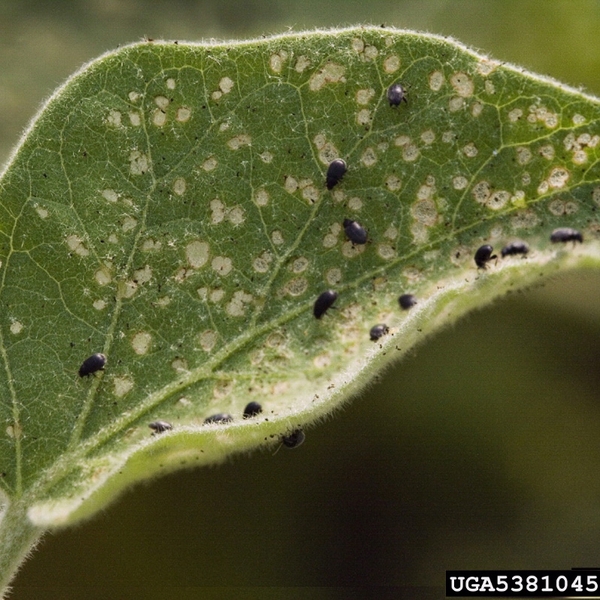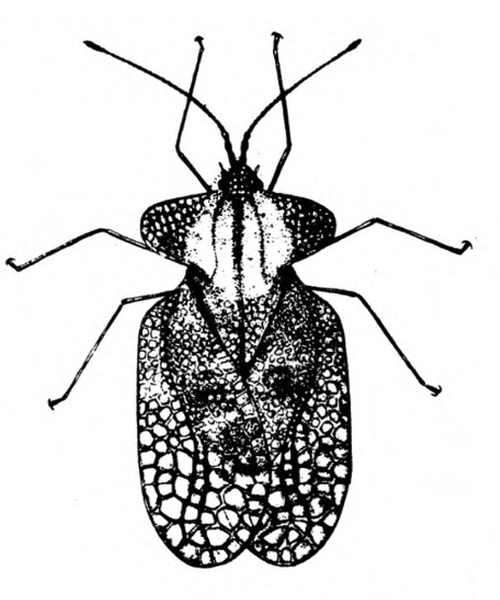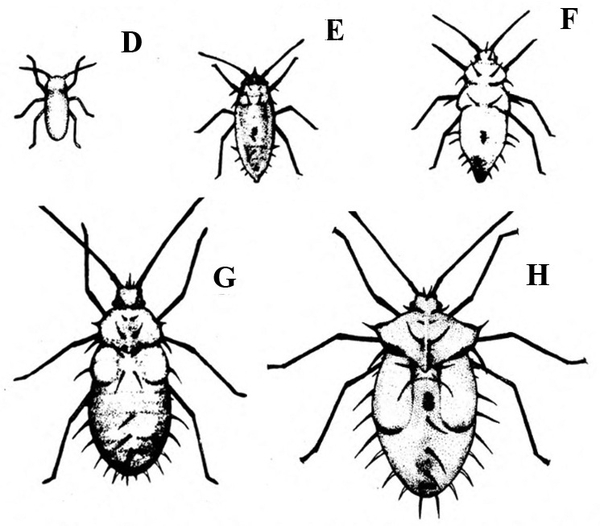A solanaceous crop related to the nightshade family of plants, eggplant has some of the same pests as pepper, potato, and tomato. The eggplant flea beetle and the eggplant lace bug are common pests, but twospotted spider mites can be more damaging.
- Chewing insects that feed on aboveground plant parts
- Beetles—Chewing insects with hard, shell-like forewings that meet in a straight line down the middle of the back. Beetles chew holes in foliage.
- Colorado potato beetle—This insect has a yellowish-brown, oval body that is 3/8 to 9/16 inch long. It has black spots on the pronotum (area behind the head) and five black stripes on each wing cover (Figure 1). The beetle feeds on terminal buds and may consume entire leaves. (For more information about Colorado potato beetles, see “Pests of Potato.”)
- Eggplant flea beetle—Black with a slightly hairy, oval body and black legs, this beetle is a little more than 1/16 inch long. The antennae are one-half to two-thirds the length of the body. The hind legs are modified for jumping. They leave tiny "shot holes" in foliage (Figure 2A).
- Potato flea beetle—Brownish-black to black, this beetle is almost 1/8 inch long. It is much less hairy than the eggplant flea beetle. The antennae are one-half to two-thirds the length of the body. The hind legs are modified for jumping. Flea beetles leave tiny "shot holes" in foliage (Figure 2B). (For more information about potato flea beetles, see “Pests of Potato.”)
- Colorado potato beetle larva—The larva is a soft-bodied, chewing insect that may grow to almost 5/8 inch long. It is red, yellowish red, or orange, with a black head, three pairs of black legs, and two rows of black spots on each side of the body. It has one pair of fleshy prolegs on the last abdominal segment (Figure 3). Like the adult beetle, it chews holes in leaves and buds. (For more information about Colorado potato beetles, see “Pests of Potato.”
- Beetles—Chewing insects with hard, shell-like forewings that meet in a straight line down the middle of the back. Beetles chew holes in foliage.
- Pests with needlelike mouthparts that feed on aboveground plant parts and extract plant juices
- Eggplant lace bug —Grayish to light brown in color, adult eggplant lace bugs (Figure 4A) cluster in herds along with spiny, yellow nymphs (Figure 4B). Adults are almost 3/16 inch long and a little more than 1/16 inch wide, with two pairs of lacelike wings and a hoodlike projection just behind or over the head. They feed in colonies on the undersides of leaves. The tops of infested leaves have roughly circular discolored areas.
- Twospotted spider mite—Tiny (almost microscopic) and pale to dark green, this pest has two or four dark spots (Figure 5). Adults and nymphs have eight legs. Larvae have six legs. Females are oval and about 1/64 inch long. Males taper toward the rear. All stages occur on undersides of leaves. Infested foliage has silvery or pale-yellow stipples. The leaves eventually become pale, then bronze, and finally dry up. Mites spin silken webs on the undersides of leaves as they feed. (For more information about twospotted spider mites, see “Pests of Beans and Peas.”)
- Soft-bodied, root-feeding pests
- Flea beetle larvae—The larvae of most species of flea beetles are cylindrical and whitish with a brown head, three pairs of legs near the head, and a pair of anal prolegs. They grow up to 3/16 inch long (Figure 6). (For more information about flea beetles, see “Pests of Potato.”)
Eggplant Flea Beetle
Epitrix fuscula Crotch, Chrysomelidae, COLEOPTERA
Description
Adult—This black, oval beetle is a little more than 1/16 inch long and has thickened hind legs for jumping. Its antennae are two-thirds the length of its body. This species resembles the potato flea beetle but has black legs and slightly hairy wing covers (Figure 7A).
Egg—Generally elliptical in shape, the egg is extremely small and pointed at one end. Though white at first, it gradually becomes yellowish gray.
Larva—A typical flea beetle larva is white with a brown head and has three pairs of brown legs near its head (Figure 7B). This species is up to 3/16 inch long when fully grown.
Pupa—Shaped essentially like adults, pupae are found in the soil. They are white at first but gradually darken (Figure 7C).
Biology
Distribution—Occurring throughout most of the United States, eggplant flea beetles tend to be most common in southern states.
Host Plants—This flea beetle has few known host species. Reports of its occurrence have been limited to eggplant, potato, horsenettle, pokeweed, sugar beet, and strawberry.
Damage—Feeding on new spring growth, eggplant flea beetles can be very destructive to young plants. They riddle foliage with holes (Figure 8), cause leaf edges to turn brown, and give plants a diseased appearance. Though older leaves often withstand injury, younger leaves may die. The larvae feed on roots and may cause damage to tuber crops such as beet and potato.
Life History—Eggplant flea beetles overwinter as adults in soil or crop debris. Their life cycle has not been studied in North Carolina, but in Indiana they are known to emerge from hibernation in mid- to late March. They infest weedy hosts such as horsenettle and pokeweed until crop hosts become available. Eggs laid in soil near the bases of plants hatch in about one week. Larvae emerge from the eggs and feed on roots or tubers for two to three weeks. After developing through three instar stages, larvae pupate in the soil. The pupal stage lasts seven to ten days. Beetles emerge from the pupal skins, make their way out of the soil, and feed on leaves for two months or more. Flea beetles complete one to four generations each year. In North Carolina, there are probably three or four annual generations.
Control
Cultural practices such as destroying crop residue, controlling weeds, and planting late help minimize flea beetle problems. Removing crop residue reduces the number of favorable overwintering sites for flea beetles. Covering plant beds and destroying trash around them also are beneficial. Controlling weeds such as horsenettle and pokeweed around garden sites eliminates important early beetle food sources. Delayed planting favors the development of host plants over the establishment of flea beetles.
A number of insecticides (granular and foliar) are available to control adult flea beetles. For recommended chemicals and rates of application, consult the North Carolina Agricultural Chemicals Manual.
Eggplant Lace Bug
Gargaphia solani Heidemann, Tingidae, HEMIPTERA
Description
Adult—The prothorax (area behind the head) of this gray or light-brown bug has a hoodlike projection that extends over the body and comes to a point over the wings. The bug has a dark head, pale-yellow legs, and two pairs of lacelike wings that are black at the base. The body appears flattened and is almost 3/16 inch long and half as wide (Figure 9A).
Egg—The extremely small, oval-elongate egg appears almost bottle-shaped. Greenish at the base and brown toward the tip, the egg has a craterlike depression in one end with a white, lacelike border. All eggs in each roughly circular cluster are deposited on end and lean in different directions (Figure 9B–C).
Nymph—Nymphs develop through five stages, ultimately growing up to 1/8 inch long (Figure 9D–H). The mature nymph is yellow with a dark spot at the tip of the abdomen and numerous spines.
Biology
Distribution—Eggplant lace bugs are most common from Maryland, Missouri, and Oklahoma southward. They occur west into New Mexico and Arizona and have also been reported in New Jersey, Pennsylvania, Connecticut, and British Columbia.
Host Plants—The eggplant lace bug has relatively few known host species. Besides eggplant, its food plants include tomato, potato, sunflower, sage, cotton, and horsenettle.
Damage—Circular, discolored areas on the foliage about the size of a quarter are the first noticeable symptoms of lace bug damage. The remains of an egg mass and a group of nymphs typically are found on the underside of each discolored leaf spot. Lace bugs gradually move outward until the whole leaf yellows and dries out. Feeding in groups, they move from leaf to leaf and eventually to new plants. A severe lace bug infestation may kill whole plants or weaken them to the extent that fruit fails to develop.
Life History—Eggplant lace bugs overwinter as adults within shriveled leaves or in other plant debris. They emerge and lay eggs in mid- to late May. Each female spends four to five days depositing 100 to 200 eggs in a basically circular mass on the underside of a leaf. The female guards her eggs against predators. When the eggs hatch about six days later, the female continues to guard her offspring. Nymphs feed and move as a colony, guided by the adult female. Molting every other day, nymphs develop through five instars and become adults in about ten days. Several days may elapse before adults of the new generation mate and deposit more eggs. About six annual generations occur on eggplant, followed by one or two additional generations on horsenettle.
Control
Eggplant lace bugs are prey of lady beetles and their larvae, spiders, and shield-shaped soldier bugs. If eggplant lace bugs become a problem, effective insecticides are available. For up-to-date recommendations, consult the North Carolina Agricultural Chemicals Manual.
Other Resources
Eggplant Flea Beetle
Aguiar, J. L. Flea Beetles, Flea Beetle: Epitrix fuscula, Epitrix hirtipennis, Systena blanda. UC IPM Pest Management Guidelines: Eggplant. Publication 3475. University of California Agriculture and Natural Resources, Statewide Integrated Pest Management Program, 2010.
Chittenden, F. H. 1899. “The Eggplant Flea Beetle, Epitrix fuscula, Crotch.” In Some Insects Injurious to Garden and Orchard Crops, Bulletin No. 19, U.S. Department of Agriculture, Division of Entomology, 87–89. Washington, DC: U.S. Department of Agriculture, 1899.
Chittenden, F. H. “The Eggplant Flea Beetle.” In Some Insects Injurious to Vegetable Crops, Bulletin No. 33, U.S. Department of Agriculture, Division of Entomology, 117. Washington DC: U.S. Department of Agriculture, 1902.
Horn, K. F., et. al. The Lace Bugs (Hemiptera: Tingidae) of North Carolina and Their Hosts. Technical Bulletin No. 257. North Carolina Agricultural Experiment Station, 1979.
Eggplant Lace Bug
Fink, D. E. The Eggplant Lace-Bug. Bulletin 239. USDA, 1915.
Heidemann, O. “A New Species of North America Tingitidae, Gargaphia solani.” In Proceedings of the Entomological Society of Washington 16 (1914): 136–37.
Horn, K. F., C. G. Wright, and M. H. Farrier. The Lace Bugs (Hemiptera: Tingidae) of North Carolina and Their Hosts. Technical Bulletin 257. North Carolina Agricultural Experiment Station, 1979.
Publication date: June 4, 2024
AG-295
Other Publications in Insect and Related Pests of Vegetables
Recommendations for the use of agricultural chemicals are included in this publication as a convenience to the reader. The use of brand names and any mention or listing of commercial products or services in this publication does not imply endorsement by NC State University or N.C. A&T State University nor discrimination against similar products or services not mentioned. Individuals who use agricultural chemicals are responsible for ensuring that the intended use complies with current regulations and conforms to the product label. Be sure to obtain current information about usage regulations and examine a current product label before applying any chemical. For assistance, contact your local N.C. Cooperative Extension county center.
N.C. Cooperative Extension prohibits discrimination and harassment regardless of age, color, disability, family and marital status, gender identity, national origin, political beliefs, race, religion, sex (including pregnancy), sexual orientation and veteran status.

